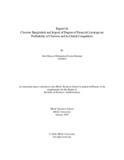| dc.contributor.advisor | Rahman, Sharmin Shabnam | |
| dc.contributor.author | Rahman, Abul Khayar Mohammod Fazlur | |
| dc.date.accessioned | 2020-08-18T18:35:57Z | |
| dc.date.available | 2020-08-18T18:35:57Z | |
| dc.date.copyright | 2020 | |
| dc.date.issued | 2020-01 | |
| dc.identifier.other | ID 15204017 | |
| dc.identifier.uri | http://hdl.handle.net/10361/13984 | |
| dc.description | This internship report is submitted in partial fulfillment of the requirements for the degree of Bachelor of Business Administration, 2020. | en_US |
| dc.description | Cataloged from PDF version of internship report. | |
| dc.description | Includes bibliographical references (pages 38-39). | |
| dc.description.abstract | The financial analysis shows Chevron Corporation stock yields lower expected return than the market at higher levels of risk. Moreover, the stocks are overvalued. Ratio analysis shows an overall satisfactory performance against its competitors in terms of leverage and profitability.
The study models the relationship of profitability; measured by return on asset; and degree of financial leverage while controlling for degree of operating leverage and degree of total leverage. The model is established using Pooled Model and Individual Effects Model in STATA on secondary accounting data. Although the results are inconclusive as number of individual observations is small (only 3 companies), it provides crucial insights. As DFL increases ROA decreases for all three models. The Fixed Effect Model (one of the Individual Effects Model) can explain 18.69% variation in return on assets and is most intuitive. It conforms to the existing theory that in the long-run, the only benefit of leverage that a firm enjoys is tax shield. Thus, capital structure decision should optimize level of debt financing to minimize the effects of taxation especially for companies like Chevron Corporation who pay nearly a third of their operating income in effective tax. | en_US |
| dc.description.statementofresponsibility | Abul Khayar Mohammod Fazlur Rahman | |
| dc.format.extent | 51 pages | |
| dc.language.iso | en | en_US |
| dc.publisher | Brac University | en_US |
| dc.rights | Brac University Internship reports are protected by copyright. They may be viewed from this source for any purpose, but reproduction or distribution in any format is prohibited without written permission. | |
| dc.subject | Financial analysis | en_US |
| dc.subject | Return on asset | en_US |
| dc.subject | Degree of financial leverage | en_US |
| dc.subject | Panel regression | en_US |
| dc.subject | Capital Asset Pricing Model (CAPM) | en_US |
| dc.subject | Weighted Average Cost of Capital (WACC) | en_US |
| dc.subject.lcsh | Financial leverage | |
| dc.subject.lcsh | Rate of return--Econometric models | |
| dc.title | Chevron Bangladesh and impact of degree of financial leverage on profitability of Chevron and its global competitors | en_US |
| dc.type | Internship report | en_US |
| dc.contributor.department | Brac Business School, Brac University | |
| dc.description.degree | B. Business Administration | |

